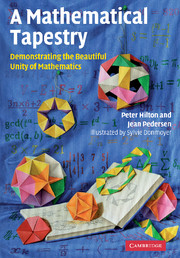Book contents
- Frontmatter
- Contents
- Preface
- Acknowledgments
- 1 Flexagons – A beginning thread
- 2 Another thread – 1-period paper-folding
- 3 More paper-folding threads – 2-period paper-folding
- 4 A number-theory thread – Folding numbers, a number trick, and some tidbits
- 5 The polyhedron thread – Building some polyhedra and defining a regular polyhedron
- 6 Constructing dipyramids and rotating rings from straight strips of triangles
- 7 Continuing the paper-folding and number-theory threads
- 8 A geometry and algebra thread – Constructing, and using, Jennifer's puzzle
- 9 A polyhedral geometry thread – Constructing braided Platonic solids and other woven polyhedra
- 10 Combinatorial and symmetry threads
- 11 Some golden threads – Constructing more dodecahedra
- 12 More combinatorial threads – Collapsoids
- 13 Group theory – The faces of the trihexaflexagon
- 14 Combinatorial and group-theoretical threads – Extended face planes of the Platonic solids
- 15 A historical thread – Involving the Euler characteristic, Descartes' total angular defect, and Pólya's dream
- 16 Tying some loose ends together – Symmetry, group theory, homologues, and the Pólya enumeration theorem
- 17 Returning to the number-theory thread – Generalized quasi-order and coach theorems
- References
- Index
Preface
Published online by Cambridge University Press: 10 November 2010
- Frontmatter
- Contents
- Preface
- Acknowledgments
- 1 Flexagons – A beginning thread
- 2 Another thread – 1-period paper-folding
- 3 More paper-folding threads – 2-period paper-folding
- 4 A number-theory thread – Folding numbers, a number trick, and some tidbits
- 5 The polyhedron thread – Building some polyhedra and defining a regular polyhedron
- 6 Constructing dipyramids and rotating rings from straight strips of triangles
- 7 Continuing the paper-folding and number-theory threads
- 8 A geometry and algebra thread – Constructing, and using, Jennifer's puzzle
- 9 A polyhedral geometry thread – Constructing braided Platonic solids and other woven polyhedra
- 10 Combinatorial and symmetry threads
- 11 Some golden threads – Constructing more dodecahedra
- 12 More combinatorial threads – Collapsoids
- 13 Group theory – The faces of the trihexaflexagon
- 14 Combinatorial and group-theoretical threads – Extended face planes of the Platonic solids
- 15 A historical thread – Involving the Euler characteristic, Descartes' total angular defect, and Pólya's dream
- 16 Tying some loose ends together – Symmetry, group theory, homologues, and the Pólya enumeration theorem
- 17 Returning to the number-theory thread – Generalized quasi-order and coach theorems
- References
- Index
Summary
This is a book of 17 chapters, each of which provides some arithmetic, some geometry, or some algebra. The basic ideas in each chapter we call threads, and there are at least nine threads in this book – paper-folding threads, number-theory threads, polyhedral threads, geometry threads, algebra threads, combinatorial threads, symmetry threads, group-theory threads, and historical threads. So this book utilizes, exploits, and develops, by weaving these threads of a very different kind together, many parts of mathematics. At the end of this preface we will give a table showing how you might read this book in the very unlikely event that you are interested in just one of these threads.
Many of the chapters involve the construction of models and these take time and effort, but we believe that if you choose to carry out the constructions you will find the activity satisfying. As Benno Artmann, reviewing one of Pedersen's articles in Mathematical Reviews, said about the construction of the golden dodecahedron: “I tried a dodecahedron. It sits on my desk, looks nice and makes me feel like an artist.” On the other hand, we understand that many of our readers won't want to construct these models, but we think that they can be appreciated without actually constructing them. Surely you yourselves have enjoyed eating a piece of cake that someone else baked; and, even though you didn't actually do the baking, you might be interested in its ingredients and how it came to be in its final shape.
- Type
- Chapter
- Information
- A Mathematical TapestryDemonstrating the Beautiful Unity of Mathematics, pp. xi - xivPublisher: Cambridge University PressPrint publication year: 2010

